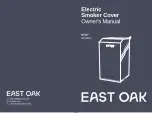
Page EN-22
Positioning
Positioning
Requirements
– To ensure proper operation, the following
requirements must be met:
– In terms of fire protection, the appliance
conforms to Type Y (EC 335-2-6). Appli-
ances of this type may be installed on one
side only next to higher kitchen furniture,
appliances or walls.
– Do not place the cooker directly next to a
refrigerator or freezer. This will increase its
energy consumption unnecessarily due to
heat emission. The best place is next to the
sink. You have an additional work surface
and dirty dishes can be washed immedi-
ately.
– If the cooker is placed on a pedestal,
measures must be taken to prevent the
appliance slipping off.
Setting up the cooker
1. Adjust the stove with a spirit level so that
the cooking zone is perfectly level.
2. Any unevenness can be compensated for
using the screw feet on the underside of
the cooker. To do this, completely pull out
the dish trolley. The best way to do this is
to put a coin into the slot and turn it.
Mounting the tilt protection
CAUTION!
If you do not install the tilt protection
securely, the whole cooker can tip for-
ward. You could injure yourself and the
cooker could be damaged in the pro-
cess.
■
Attach the supplied tilt protection
to the wall before use to prevent the
cooker from tipping over.
■
Do not lean, sit or stand on the oven.
If the oven door is loaded with a
heavy weight e.g. a large pan, the ap-
pliance can tilt forwards and fall over.
1. Set up the cooker as described and align
it accurately.
2. Draw a horizontal line on the wall from the
inside of the housing along the underside
of the middle slot.
3. Pull out the cooker again.
(f)
(h)
(g)
4. Position the tilt protection (f) on the line on
the wall such that the side with the holes
lies flat against the wall and the protruding
limb fits into the slot on the cooker.
5. Mark both drill holes through the holes
in the bracket. Note the height of the drill
holes:
– (g): 6.0 cm from the floor
– (h): 10.3 cm from the floor.
6. Use a metal detector to make sure there
are no cables or piping in the area to be
drilled. If there are, select another location
for assembly.
7. Drill a dowel hole in each marked posi-
tions using a masonry drill.
8. For solid walls: Place the supplied dowels
into the holes. Screw the tilt protection
tight with the supplied screws.
For drywalls: Obtain suitable special dow-
els for the wall. If necessary, consult a
professional.
Screw the tilt protection to the wall with
suitable screws for the dowels.










































